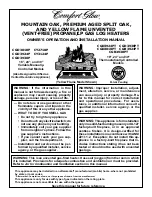
20
CLEANING AND SERVICING
PILOT FLAME CHARACTERISTICS
BURNER FLAME CHARACTERISTICS
Annual inspection and cleaning by your dealer or qualified
service technician is recommended to prevent malfunction and/
or sooting.
TURN OFF HEATER AND ALLOW TO COOL BEFORE CLEANING.
PERIODIC CLEANING - Refer to parts diagram on page 14 for
location of items dicussed below.
• Do not use cleaning fluid to clean logs or any part of the heater.
• Logs - Brush logs with soft bristle brush, or vacuum with brush
attachment.
• Remove loose particles and dust from the burner areas,
controls, piezo covers and grate.
• Inspect and clean burner air intake hole. Remove lint or
particles with brush. Failure to keep air intake hole clean will
result in sooting and poor combustion.
Figure 20-1 shows a correct pilot flame pattern. The correct flame
will be blue and will extend beyond the thermocouple. The flame
will surround the thermocouple just below the tip. A slight yellow
flame may occur where the pilot flame and main burner flame
meet.
Figure 20-3 shows a correct burner flame pattern. The correct
flame will be blue at the base and yellow at the tip. Flame should
be vertical in shape and should not impinge decorative logs.
ANNUAL CLEANING/INSPECTION - Refer to parts diagram for
location of items discussed below:
• Inspect and clean burner air intake hole. Remove lint or
particles with vacuum or brush. Failure to keep air intake hole
clean will result in sooting and poor combustion.
• Inspect and clean all burner ports.
• Inspect ODS pilot for operation and accumulation of lint at air
intake holes.
• Verify flame pattern and log placement for proper operation.
• Verify smooth and responsive ignition of main burner.
Figure 20-2 shows an incorrect flame pattern. The incorrect pilot
flame is not touching the thermocouple. This will cause the log
set to shut down.
FIG . 20-3
Correct ODS pilot flame
FIG . 20-1
Incorrect ODS pilot flame
FIG . 20-2




































